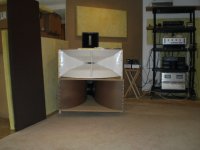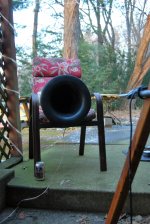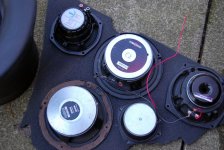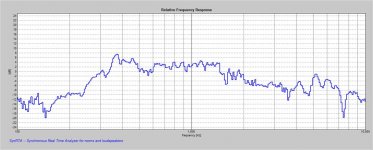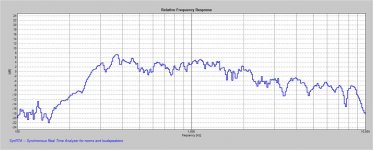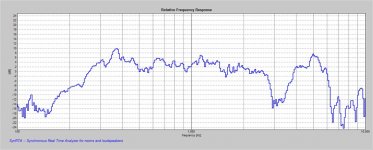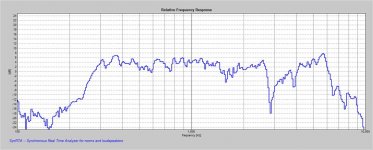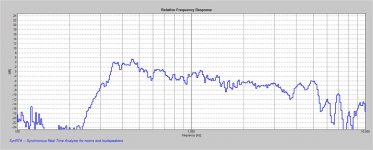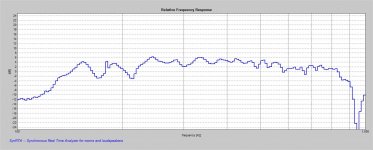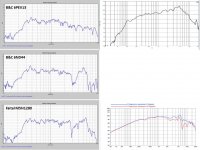I like the Edgar just fine. I was waiting for an answer from Line Source as to an example of a good bi-radial meant for a 6-6.5 inch.
What are the advantages of bi-radial horns vs. Tractrix?
I only have the 12 ohm Faital, the phase plug in the B&C is small and probably doesn't do much in a horn and the Audax MO I'm tlking about has no phase plug. The 18 Sound driver in the graph might be good in a horn. I'll see if I can measure the Audax MO, Faital and B&C this weekend for comparison. If I do it will be in the big 180 flare Sierra Brooks tractrix horns throat set at 4"
Frequency response looks good, although the 12 Ohm displays a dip around 2kHz and from that point of view the 8Ohm looks better.
Also of note is neither this one nor the LE5 have phase plugs, vs the 6PEV and the PR170zo that do.
Do you happen to have measurements of the Faital Pro in a horn?
FWIW, below is a table with the better looking 5-6.5" drivers. I have a similar one for 8". The darker the shading the better.
Bi-radial horns can be made to have constant directivity, Tractrix have a progressively narrowing pattern at higher frequencies.What are the advantages of bi-radial horns vs. Tractrix?
... and bi-radial allow a lower XO vs horn size !
If I understood, bi-radial has a quality with room coupling : often our ceilling as less high than the horizontal width of our rooms !
If I understood, bi-radial has a quality with room coupling : often our ceilling as less high than the horizontal width of our rooms !
white whales ?
Ah ! So, the EV HR-9040's I have must be bi-radial.
Thank you so much, this is good to know 🙂
Bi-radial horns can be made to have constant directivity, Tractrix have a progressively narrowing pattern at higher frequencies.
Ah ! So, the EV HR-9040's I have must be bi-radial.
Thank you so much, this is good to know 🙂
Attachments
Scott,Ah ! So, the EV HR-9040's I have must be bi-radial.
Thank you so much, this is good to know 🙂
The EV HR-9040 has a hyperbolic-exponential throat connected to a conical main section, not technically a bi-radial, but does have constant horizontal directivity from 315 Hz to 16kHz. They have the classic Keele secondary expansion, which gets the low end response a bit closer to the "sacred" exponential radial horns the HR series broke away from, and prevents the midrange "waistbanding" a single section conical horn exhibits.
Keele's later JBL horns were dubbed bi-radial, no conic (straight sided) portions were used in those horns, and the expansion did not have the secondary "break" associated with his earlier Altec and EV designs. The bi-radial designs have more low end response for their size compared to the conical expansion.
Art
Last edited:
Ah the size !
Btw, nice compact system Scott L ! I'm really looking Something compact like it looks on your photograph if your system...)
(Is it Rock wool panels here nad there in your room ? (just in case it is and not proof: to be avoid for health disease at long term or if children at home, lungs don't like it)
Btw, nice compact system Scott L ! I'm really looking Something compact like it looks on your photograph if your system...)
(Is it Rock wool panels here nad there in your room ? (just in case it is and not proof: to be avoid for health disease at long term or if children at home, lungs don't like it)
Bi-radial horns can be made to have constant directivity, Tractrix have a progressively narrowing pattern at higher frequencies.
Thank you. Could you please point me to constant directivity DIY horns you know of?
I've looked some into Yuichi horns before. But don't know if those could be made to match a 5 or 6.5" midrange cone driver. Are Yuichis constant directivity?
The link I gave in post #2 is an example of a constant directivity DIY horn. Two-part conical horns are the easiest constant directivity horns to build.
Bwaslo's calculator will give you cut angles and sizes for any horn of that type:
Index of /SynergyCalc
Constant directivity means the off axis response remains the same regardless of frequency, down to the frequency where the mouth size is not large enough to control the pattern of the longer lower wavelengths. Bwaslo's calculator has the pattern control frequency as the determinate for the horn dimensions.
This would be an example of a multiple entry constant directivity DIY horn:
SynTripP: 2-way 2-part Virtual Single Point Source Horn - diyAudio
The Yuichi is a radial horn, while it may have uniform horizontal pattern control, the vertical response narrows at higher frequencies, so it is not constant directivity.
Radial (or any type of) horns can be made to fit any size driver. That said, as the driver size is increased, it will "beam" (dispersion becomes more narrow) at a lower frequency. To reduce beaming, the horn throat size can be made smaller than the driver's cone, though that may require a phase plug to align arrival time from the various portions of the cone. The resulting higher compression ratio when using a phase plug requires a higher Bl (magnetic strength) to control the cone, and the higher pressures require a stiffer (heavier) cone, limiting HF response.
Art
Bwaslo's calculator will give you cut angles and sizes for any horn of that type:
Index of /SynergyCalc
Constant directivity means the off axis response remains the same regardless of frequency, down to the frequency where the mouth size is not large enough to control the pattern of the longer lower wavelengths. Bwaslo's calculator has the pattern control frequency as the determinate for the horn dimensions.
This would be an example of a multiple entry constant directivity DIY horn:
SynTripP: 2-way 2-part Virtual Single Point Source Horn - diyAudio
The Yuichi is a radial horn, while it may have uniform horizontal pattern control, the vertical response narrows at higher frequencies, so it is not constant directivity.
Radial (or any type of) horns can be made to fit any size driver. That said, as the driver size is increased, it will "beam" (dispersion becomes more narrow) at a lower frequency. To reduce beaming, the horn throat size can be made smaller than the driver's cone, though that may require a phase plug to align arrival time from the various portions of the cone. The resulting higher compression ratio when using a phase plug requires a higher Bl (magnetic strength) to control the cone, and the higher pressures require a stiffer (heavier) cone, limiting HF response.
Art
Last edited:
SynTripP is IMPRESSIVE work! Congratulations. Too large, unfortunately, for my environment. One of the concerns is particularly with the height of some horns. Hence my aesthetic attraction towards Tractrix and Yuichis, for example.
I liked this work on Yuichis: http://www.diyaudio.com/forums/multi-way/242262-pics-diy-yuichi-290hz-wood-horn.html
Is it a long shot to aim for 400-2000 Hz out of Yuichis with a 5 or 6.5" cone? Bad idea?
Would Tractrix be a better path for my use & needs? Or other type of horn?
Is constant vertical directivity a big deal in a living room environment where listening takes places sitting at a given place?
What would be the effect of using a horn starting at 350Hz even if it looses pattern control say at 500Hz? Sorry for the very basic questions...it's 101 indeed 😱
thanks for all the help!
I liked this work on Yuichis: http://www.diyaudio.com/forums/multi-way/242262-pics-diy-yuichi-290hz-wood-horn.html
Is it a long shot to aim for 400-2000 Hz out of Yuichis with a 5 or 6.5" cone? Bad idea?
Would Tractrix be a better path for my use & needs? Or other type of horn?
Is constant vertical directivity a big deal in a living room environment where listening takes places sitting at a given place?
What would be the effect of using a horn starting at 350Hz even if it looses pattern control say at 500Hz? Sorry for the very basic questions...it's 101 indeed 😱
thanks for all the help!
Lewinski,
If smaller size is one of your goals, have you seen these horns?
http://www.diyaudio.com/forums/multi-way/285030-bookshelf-multi-way-point-source-horn.html
If smaller size is one of your goals, have you seen these horns?
http://www.diyaudio.com/forums/multi-way/285030-bookshelf-multi-way-point-source-horn.html
with a 2" throat, you may better use a 3"/4" driver to reach 100 dB ! Maybe be possible with the TC7 Vifa or than 10/8 ScanSpeak.
Yuichi copies are often bad and expensive; e.g. on your link : straight side walls, not slighty curved as the orginal ! It can been seen at measurement as at ears ! 6 wave guides instead 4 at the throat ! bad positionning of the guide lenses ...
You need to know the polar patern behavior of the horn at the choosed XO ... to match the Beyma !
You should have better result with a cheap 511B horn than a bad Yushi copy. But your 400 Hz with Beymas is certainly too low !
Remember than the dB attenuation of a planar is not the same as a driver, so you need to know your listening distance for your simulations because the TPL(H)150 planar ! Is it 3 meters, 6 meters, etc !
Often these horns are better at long distance (> 6 m) or the soundstage an Phantom behavior of the speaker could suffer ! I'm sure some will say the opposite ! I just talk from listening experience and not designing !
Yuichi copies are often bad and expensive; e.g. on your link : straight side walls, not slighty curved as the orginal ! It can been seen at measurement as at ears ! 6 wave guides instead 4 at the throat ! bad positionning of the guide lenses ...
You need to know the polar patern behavior of the horn at the choosed XO ... to match the Beyma !
You should have better result with a cheap 511B horn than a bad Yushi copy. But your 400 Hz with Beymas is certainly too low !
Remember than the dB attenuation of a planar is not the same as a driver, so you need to know your listening distance for your simulations because the TPL(H)150 planar ! Is it 3 meters, 6 meters, etc !
Often these horns are better at long distance (> 6 m) or the soundstage an Phantom behavior of the speaker could suffer ! I'm sure some will say the opposite ! I just talk from listening experience and not designing !
Last edited:
1) The SynTripP without the secondary horn expansion is 26.5 x 11.25 tall, 15" deep. The Yuichi you link below appears to be about the same size.1)SynTripP is IMPRESSIVE work! Congratulations. Too large, unfortunately, for my environment. One of the concerns is particularly with the height of some horns. Hence my aesthetic attraction towards Tractrix and Yuichis, for example.
2)I liked this work on Yuichis: http://www.diyaudio.com/forums/multi-way/242262-pics-diy-yuichi-290hz-wood-horn.html
Is it a long shot to aim for 400-2000 Hz out of Yuichis with a 5 or 6.5" cone? Bad idea?
3)Would Tractrix be a better path for my use & needs? Or other type of horn?
4)Is constant vertical directivity a big deal in a living room environment where listening takes places sitting at a given place?
5)What would be the effect of using a horn starting at 350Hz even if it looses pattern control say at 500Hz? Sorry for the very basic questions...it's 101 indeed 😱
thanks for all the help!
2)That range is easily possible with a large radial horn.
3) After 7 pages, I still don't have a clear idea of your use or needs, other than aesthetic considerations.
4)You hear the room response as well as the on axis response. Reflected sound with a different response than the on axis sound does not sound right. If I were using horns in my living room, that would be a Big Deal to me.
5)The effect is the upper response sounds more clear (direct), and the lower more reverberant (reflected). That said, pattern control is less important down low, and it takes a much larger horn than you are willing to use to have control down to 350 Hz.
Art
I only have the 12 ohm Faital, the phase plug in the B&C is small and probably doesn't do much in a horn and the Audax MO I'm tlking about has no phase plug. The 18 Sound driver in the graph might be good in a horn. I'll see if I can measure the Audax MO, Faital and B&C this weekend for comparison. If I do it will be in the big 180 flare Sierra Brooks tractrix horns throat set at 4"
If you happen to get to measure these, which I sure hope you do 😀, please also post pictures of the driver and horn used.
I was under the impression the Faital M5N12 had a closed carcass behind the cone, much like the JBL CMCDs, but found a picture that seems said carcass doesn't close behind the cone - only around the magnet. So the Faital needs an enclosure?
BTW, what do you guys think of Beyma 605Nd for horn loading, 350 to 2000Hz?
Last edited:
View attachment 534272
View attachment 534273
All open back about 4 feet 50 db scale 1/48 smoothing pink noise - none of these are true "midrange" to me because my definition is 160 to 1300 Hz, so upper midrange. Guess which one sounds best LOL
Audaz PR170MO
View attachment 534274
B&C 6PEV13
View attachment 534276
B&C 6nd44
View attachment 534275
Faital M5N1280
View attachment 534278
Cheap ebay 4" closed back
View attachment 534277
BIG THANK YOU for doing this!!!
Very interesting. I'm still processing. Hopefully you guys can help me with the takeaways.
You note all measurements were taken with drivers mounted with open back. Is this the best way to implement a cone+horn, or just because it was the only way to make comparable measurements? Naturally you didn't have a an enclosure for each driver.
The horn you used has conical shape? And the drop below 300Hz seen on all drivers is a factor from the horn, right?
Keeping in mind my intended range will be somewhere within 350/500 to 2000/2500Hz, with very steep digital xo:
- They all seem suitable, but there are differences.
- The cheap eBay 4" might be the best for the money, but I'll drop it.
- The Audax seems the least able, but it is the MO version and not the ZO Scott mentioned.
- I couldn't find references online to B&C 6ND44. From the picture it seems a B&C driver, but couldn't find it on their website. Thaought maybe it was an 18Sound 6NDA, but they don't show a 6NDA44.
- The 6PEV13 and M5N12-80 both look good on the graph. My reading:
- M5N12 is smoother in the 300-2000Hz range, with a dip in the 1500-1800Hz range. The sharp drop around 2600Hz correlates with the manufacturer's chart, I think. Shouldn't be a big deal for me if crossed at 2000Hz, right?
- 6PEV13 would be advantageous if I wanted to cross over higher than 2500 Hz. Right?
I must admit the minimum impedance of the M5N12 at 8.8 ohm is appealing for use with a SET, vs 6 ohm for the 6PEV13.
I like where this is going!
Attachments
This the 8" B&C at 5 feet in room crossovers in place. 120 and 800. You need to be back double that or 10' and then the low mid snaps into full bloom 🙂 1/48 smoothing pink noise - they will go to around 1.2k
View attachment 534295
Is this the 8PE21? In a horn?
meaning given the xo you are applying? I thought these were good up higher. If 1.2kHz is as far as they can play with goood sound then I should drop them. 1.2k is too low a xo for my needs.they will go to around 1.2k
The Faital is more lively and is first choice provided the upper range can be attenuated in the crossover. The 6pev13 is the easiest to get the most of using first order networks. Nice upper midrange tone but not as realistic or alive as the Faital. The cheap 4" can sound great with the right high pass.. all the way out to the upper treble. lol
I wrote the B&C 6" model number wrong
B&C 6MDN44 6-1/2" Neodymium Midrange Speaker
I wrote the B&C 6" model number wrong
B&C 6MDN44 6-1/2" Neodymium Midrange Speaker
Is this the 8PE21? In a horn?
meaning given the xo you are applying? I thought these were good up higher. If 1.2kHz is as far as they can play with goood sound then I should drop them. 1.2k is too low a xo for my needs.
They are in a 4 foot deep horn, 1.2K is sort of a miracle
- Home
- Loudspeakers
- Multi-Way
- Cone midrange horn 101
